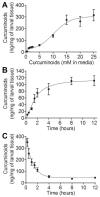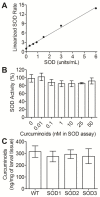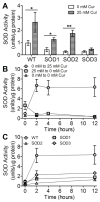Assessing Curcumin Uptake and Clearance and Their Influence on Superoxide Dismutase Activity in Drosophila melanogaster
- PMID: 37754202
- PMCID: PMC10526445
- DOI: 10.3390/biotech12030058
Assessing Curcumin Uptake and Clearance and Their Influence on Superoxide Dismutase Activity in Drosophila melanogaster
Abstract
While normal levels of reactive oxygen and nitrogen species (RONS) are required for proper organismal function, increased levels result in oxidative stress. Oxidative stress may be managed via the scavenging activities of antioxidants (e.g., curcumin) and the action of enzymes, including superoxide dismutase (SOD). In this work, the uptake and clearance of dietary curcuminoids (consisting of curcumin, demethoxycurcumin, and bisdemethoxycurcumin) was assessed in Drosophila melanogaster larvae following chronic or acute exposure. High levels of curcuminoid uptake and loss were observed within a few hours and leveled off within eight hours post treatment onset. The addition or removal of curcuminoids from media resulted in corresponding changes in SOD activity, and the involvement of each of the three SOD genes was assessed for their contribution to total SOD activity. Taken together, these data provide insight into the uptake and clearance dynamics of curcuminoids and indicate that, while SOD activity generally increases following curcuminoid treatment, the individual SOD genes appear to contribute differently to this response.
Keywords: Drosophila; curcumin; superoxide dismutase.
Conflict of interest statement
The authors declare no conflict of interest. The funders had no role in the design of the study; in the collection, analyses, or interpretation of data; in the writing of the manuscript; or in the decision to publish the results.
Figures



References
Grants and funding
LinkOut - more resources
Full Text Sources
Molecular Biology Databases
